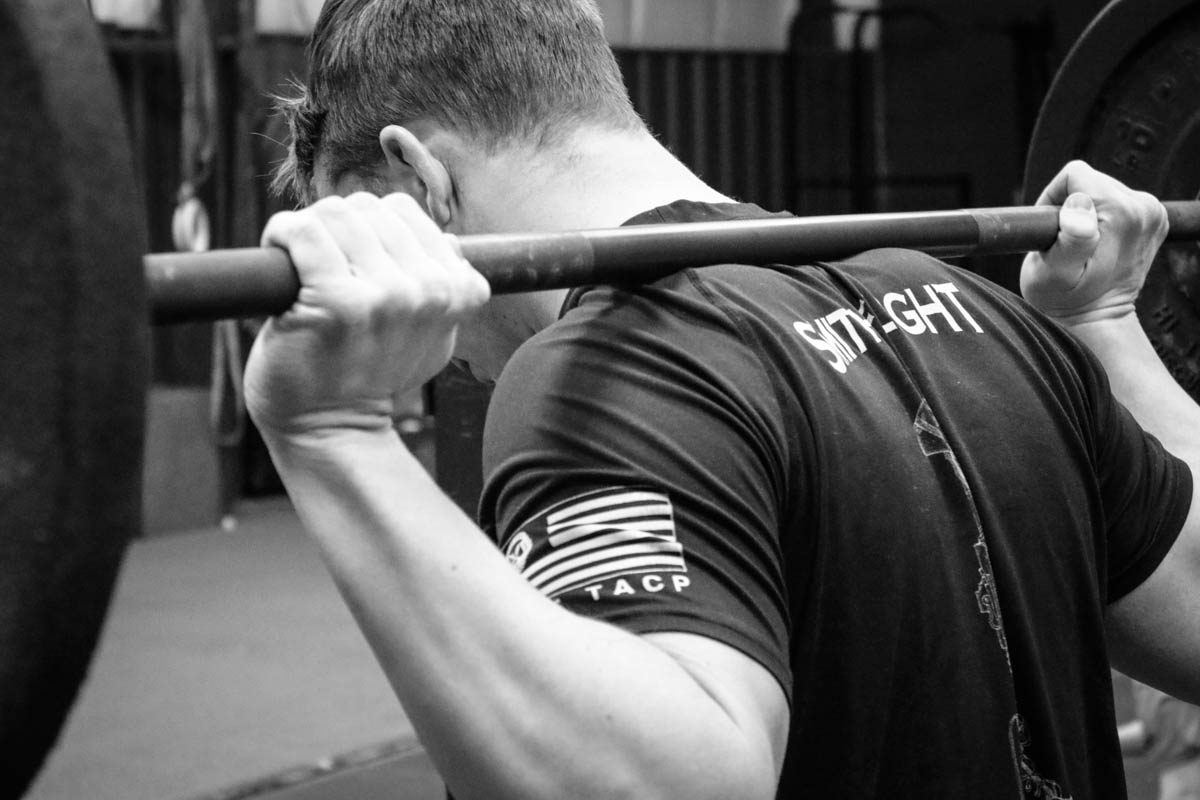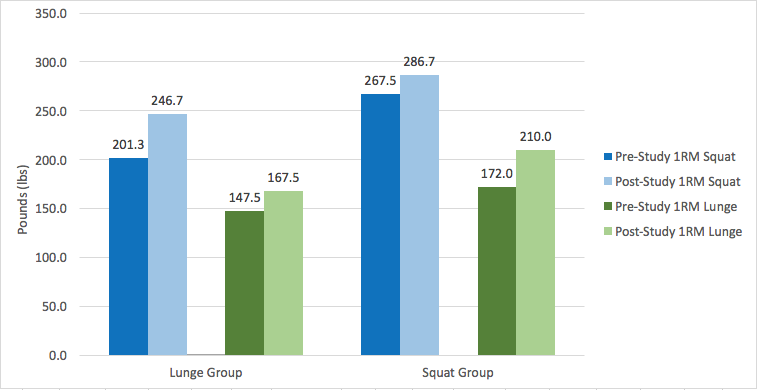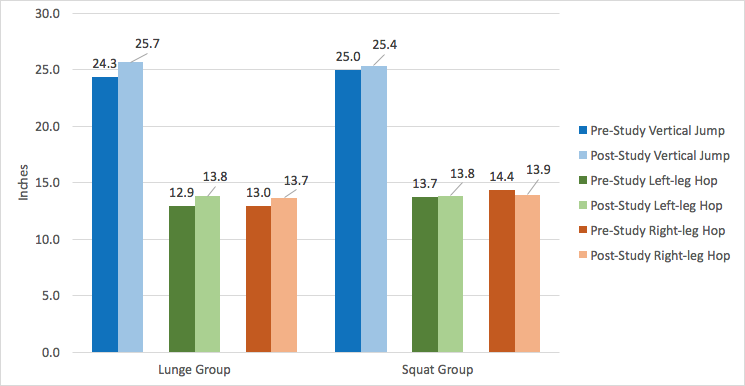
By Adam Scott and Rob Shaul
1. Purpose
Some coaches have taken a stance against traditional bilateral movements, saying that squat-based training is less safe and less transferable to athletic performance.
The purpose of this mini-study was to test the effects of both squat-based and lunge-based training on high school athletes. Is one type of training better at improving strength, power or agility?
2. Subjects
Ten voluntary members of a high school strength and conditioning program participated in the study (nine male and one female). The subjects had a mean age of 16.5 years (+/-1.1), a mean height of 67.0 inches (+/- 2.5), a mean weight of 159.0 pounds (+/-42.1) and 2.7 years (+/- 1.3) of strength training experience.
3. Design
Subjects trained 3 times per week for 5.5 weeks. Subjects were divided into two groups: Squat-based and Lunge-based. The two groups completed nearly identical training programs. The sole difference was the lower body movements. The squat group trained back squat, front squat and box squats. While the lunge group trained barbell lunges, barbell split squats and rear leg elevated split squats (RLESS) with dumbbells. Due to the group sizes and the requirements of the after-school program, unfortunately, no control group was utilized.
4. Results & Discussion
Both groups had statistically significant gains in strength (1RM Squat and 1RM Lunge) and agility (Pro Agility and T-Agility). One of the most peculiar findings in the study was that the lunge group actually improved more than the squat group on their 1RM squat (22.6% and 7.2%, respectively) and the squat group improved more than the lunge group on their 1RM lunge (22.1% and 13.6%, respectively). Improvements in agility were fairly even between the lunge group and squat group (8.6 and to 5.8% in the Pro Agility, respectively; and 9.9% and 5.5% in the T-Agility, respectively).
GRAPH 1: Pre-Training and Post-Training Strength Measures

GRAPH 2: Pre-Training and Post-Training Agility
(Note: Decreases in time mean better performance)

Based on our three measures of lower body power (vertical jump, left-leg vertical hop and right-leg vertical hop) neither type of training produced statistically significant improvements. The lunge group did improve slightly more than the squat groups, but none of these differences met the threshold for statistical significance.
GRAPH 3: Pre-Training and Post-Training Lower Body Power

5. Conclusion and Recommendations
When it comes to building strength and agility there does not appear to be a significant difference between squatting and lunging. Furthermore, it seems that neither type of training alone is sufficient to build lower-body jumping power.
It should be noted that in our study the lunge group did out-improve the squat group in every measure except the 1RM lunge. Although none of these between-group differences were large enough to be statistically significant they were noticeable and could possibly hint at some unmeasured benefit.
Therefore, if a coach had to pick only one form of training we would recommend unilateral training like lunges. However, our study does show that squatting does have a positive impact on both strength and agility.
Read the full report → Squat vs Lunges White Paper
REFERENCES
- Ebben, W; Feldman, C; Dayne, A; Mitsche, D; Chmelewksi, L; Alexander, P and Knetgzner, K. Using squat testing to predict training loads for the deadlift, lunges, step-up, and leg extension exercises. J Strength Cond Res; 22(6): 1947-1949, 2008.
- Makaruk, H; Winchester, J; Sandowski, J; Czaplicki, A and Sacewitz, T. Effects of unilateral and bilateral plyometric training on power and jumping ability in women. J Strength Cond Res; 25(12): 3311-3318, 2011.
- Declore, G; Mathieu, W; Salazar, W and Hernandez, J. Comparison between one-leg and two-leg plyometric training on vertical jump performance [abstract]. Med Sci Sports Exec; 30 (Suppl): 61, 1998.
- Ebben, W; Feldman, C, Vanderzanden, T; Faucht, M and Petushek, E. Periodized plyometric training is effective for women and performance is not influenced by the length of the post-training recovery. J Strength Cond Res; 24:1-7, 2010.
- Marques, M and Gonzalez-Badillo, J. In-season resistance training and detraining in professional team handball players. J Strength Cond Res; 20: 563-571, 2006.
- McCury, K; Langford, G; Doscher, M; Wiley, L and Mallard, K. The Effects of short-term unilateral and bilateral lower-body resistance training on measures of strength and power. J Strength Cond Res; 195(1): 9-15, 2005.
- Gottshalk, F; Kourosh, S and Leveau, B. The functional anatomy of tensor fasciae later and gluteus medium and minibus. J Anat; 166: 179-189, 1989.
- Neuman, D and Cook, T. Effect of load and carrying position on the electromyographic activity of the gluteus medium muscles during walking. Phys Ther; 65: 305-311, 1985.
- Migiano, M; Vingren, J; Volek, J; Maresh, C; Fragala, M; Ho, J; Thomas, G; Hatfield, D; Hakkinen, K; Ahtianen, J; Earp, J and Kraemer, W. Endocrine response patterns to acute unilateral and bilateral resistance exercises in men. J Strength Cond Res; 24(1): 128-134, 2010.
- Speirs, D; Bennet, M; Finn, C and Turner, A. Unilateral vs Bilateral squat training for strength, sprints and agility in academy rugby players. J Strength Cond Res (published ahead of print), 2015.
- DeForest, B; Cantrell, G and Schilling, B. Muscle activity in single- vs double-leg squats. Int J Ex Science; 7(4): 302-310. 2014.
- Boyle, M. Build better legs, one at a time. Perform Better. Updated: 2015. http://www.performbetter.com/webapp/wcs/stores/servlet/PBOnePieceView?storeId=10151&catalogId=10751&pagename=372. Accessed: 13 MAR 2016.
You Might Also Like Geek Cycle: Leg Blasters Match Front Squat in Building Lower Body Strength
STAY UPDATED
Sign-up for our BETA newsletter. Training tips, research updates, videos and articles - and we’ll never sell your info.
